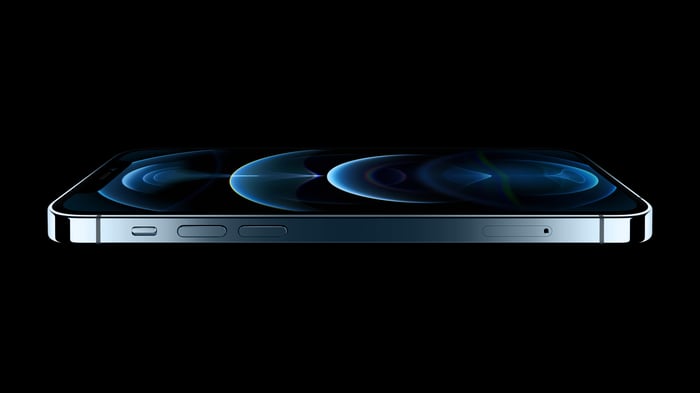It's iPhone Day 2020, and Apple (AAPL -2.41%) just showed off its latest flagship iPhone and a new affordable smart speaker. There was no mention of the AirTags accessory that could help people locate lost items, or any updates around Arm-based Macs or how many Apple Music subscribers there are now.
Here's everything that Apple showed off today.

iPhone 12 Pro. Image source: Apple.
iPhone 12
As expected, the next iPhone will feature 5G cellular technology across all new models. Apple has overhauled the lineup's design, resembling the boxier iPad Pro and some older iPhones. The standard iPhone 12 will have the same 6.1-inch display as last year's iPhone 11, but the smartphone is -- you guessed it -- thinner and lighter. However, the display has a higher resolution with twice as many pixels.
Apple has collaborated with Corning to develop a new cover glass material that it's calling Ceramic Shield, which should improve durability and minimize damage from drops. There is an updated dual-camera system, and Apple is adding a magnetic system, repurposing its old MagSafe branding. Those magnets will make it easier to properly align a wireless charger and can also be used for other accessories.

iPhone 12 and 12 Mini. Image source: Apple.
The company is adding a smaller iPhone 12 Mini to the lineup with a 5.4-inch display. That model has essentially all of the same features as the standard iPhone 12 but in a smaller form factor.
The Pro models use the same design but swap out aluminum for stainless steel as the chassis material. iPhone 12 Pro is getting a larger 6.1-inch display, up from last year's 5.8-inch screen, while iPhone 12 Pro Max will get a 6.7-inch display.
The triple-camera system is similarly getting a revamp with improved photo and video performance. The Pro models also include a lidar sensor in the camera system, which was expected after Apple added that sensor to the iPad Pro earlier this year. The inclusion of lidar will allow the iPhones to better understand their environments, which will be useful for augmented reality (AR) applications, as well as contribute to photo quality.
Here's what the new lineup looks like.
|
Model |
Display Size |
Starting Price |
|---|---|---|
|
iPhone 12 Mini |
5.4 inches |
$699 |
|
iPhone 12 |
6.1 inches |
$799 |
|
iPhone 12 Pro |
6.1 inches |
$999 |
|
iPhone 12 Pro Max |
6.7 inches |
$1,099 |
Data source: Apple.
The iPhone 12 and 12 Pro can be pre-ordered on Friday and will ship a week later, while the Mini and Max models will ship in early November.

HomePod Mini. Image source: Apple.
HomePod Mini
Years after launching the overpriced HomePod, Apple has finally announced its oft-rumored HomePod Mini, priced at $99. The new speaker is smaller, has a spherical design, and features a backlit touch surface on the top that displays visualizations. HomePod Mini looks like an upside-down version of Amazon's new Echo Dot, except it costs twice as much.
The original HomePod, which was initially priced at $350, was never a strong seller and failed to make a dent in the booming smart-speaker market. Apple is still touting superior audio quality, pointing to an S5 chip that powers computational audio that optimizes the speaker's acoustics. HomePod Mini will include Apple's U1 Ultra Wideband chip for short-range communications with other Apple gadgets that have the chip.
One of the main criticisms of the original HomePod was that it only directly supported integration with Apple Music, limiting the appeal to consumers that might use another streaming service. Apple will add support for SiriusXM's Pandora and Amazon Music -- but not Spotify, the most popular paid music streaming service in the world. That omission will not help dispel the ongoing antitrust scrutiny.





